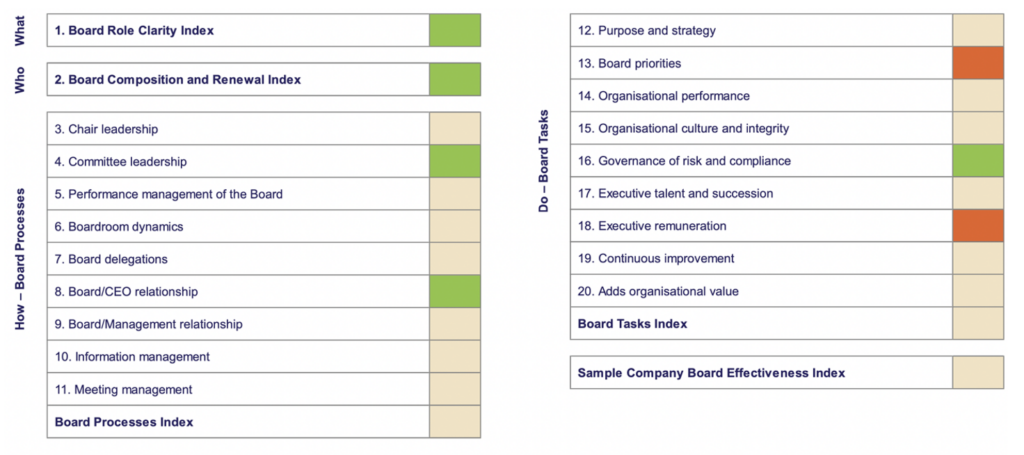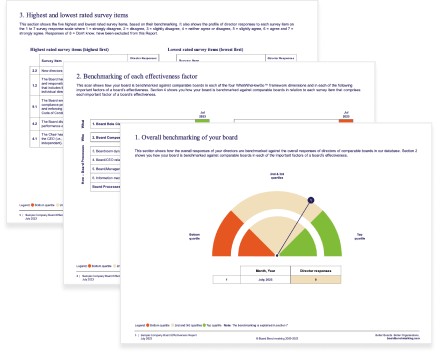Our WhatWhoHowDo Framework
Benchmarking makes all the difference.
Our Board Effectiveness Framework
Our Board Effectiveness Survey uses the world-recognised WhatWhoHowDo Framework.
The dimensions of our WhatWhoHowDo Framework were refined in early 2020, following a comprehensive review with the assistance of Deakin University, Melbourne. The review established psychometrically defensible dimensions of board functioning. That review and analysis of contemporary board literature helped create a valid world-class board survey.
Very few, if any, other board frameworks and surveys have been subject to the same form of rigorous review. One reason is that such reviews require significant data, ideally from at least several hundred board reviews, which most board review firms have not yet completed.
The review referred to above identified 20 discrete factors as being the most important in assessing and measuring the effectiveness of a board.
Each board’s effectiveness is first benchmarked against boards of comparable organisations, as shown below.

Each board is also benchmarked in relation to the 20 most important dimensions for a board’s effectiveness, as shown in the example below.

Each survey item comprising each of the 20 dimensions is benchmarked, as shown in our sample report.
Many clients tell us that our benchmarking makes all the difference! They say if our benchmarking colours were removed, interpreting our reports would be much more difficult. Our report design and use of benchmarking make our report intuitive and easy to understand. ‘Hot spots’ are highlighted very quickly and easily.
Click here if you want to try our short 4-minute FREE Trial survey for individuals to see how your responses are benchmarked.
The 20 most important categories of a board’s effectiveness are explained in detail below.
WHAT – Board Clarity – ie. Adding Role
- Board Role Clarity
An effective board starts with clear role definitions. Directors must understand how their responsibilities differ from management’s, reinforced through up-to-date board and committee charters. Clarity of roles reduces confusion, prevents overreach, and builds a strong foundation for accountability, collaboration, and good governance at both strategic and operational levels.
WHO – Board Composition and Renewal
- Board Composition and Renewal
A high-functioning board is built intentionally. This includes a thoughtful blend of skills, experiences and perspectives, underpinned by robust succession planning. Proactive recruitment, structured inductions, and a regular skills matrix review ensure that the board evolves alongside the organisation and remains capable of meeting emerging challenges.
HOW – Board Processes
- Chair Leadership
The Chair’s leadership is foundational. An effective Chair sets the tone, fosters healthy debate, and ensures the board remains focused on strategic outcomes. They guide decision-making with sound judgement, manage dissent respectfully, and act as a bridge between the board and management to promote cohesion and momentum.
- Committee Leadership
Committees only work when their leadership is strong. Chairs must set clear expectations, lead with purpose, and communicate insightfully with the board. They also need to work productively with management, ensure committee work adds value, and provide structured reports that feed directly into effective board deliberation and decisions.
- Performance Management of the Board
Boards must hold themselves to account. Regular evaluation of individual and collective effectiveness helps surface blind spots and reinforce a high-performance culture. Boards should address underperformance early, provide developmental feedback, and ensure the Chair and committee leaders are also assessed in a structured and meaningful way.
- Boardroom Dynamics
Boards are most effective when they work as a team. Constructive dynamics allow disagreement without discord and encourage inclusive, respectful dialogue. Creating a psychologically safe environment — where directors can challenge ideas without fear of criticism — is key to unlocking innovation and better decision-making around the board table.
- Board Delegations
The boundaries between board and management should be well understood. Clear, up-to-date delegations support faster decisions and reduce ambiguity. Both directors and executives must understand what matters require board input, and where autonomy exists, to promote trust, reduce bottlenecks, and ensure decisions are made at the right level.
- Board/CEO Relationship
A productive Chair-CEO relationship is collaborative, transparent, and grounded in mutual respect. While the board supports the CEO, it must remain independent and provide rigorous oversight. Effective performance review processes and open communication help strengthen trust and alignment on vision, strategy, and leadership priorities.
- Board/Management Relationship
Strong governance is built on a foundation of mutual trust and open dialogue between the board and management. Boards should challenge and support management thinking, while providing direction and feedback. Management, in turn, must feel confident in raising concerns early and engaging the board in critical conversations.
- Information Management
Boards depend on timely, forward-looking, and well-curated information to govern effectively. Management should provide strategic insights — not just operational data — that enable informed oversight and decision-making. Responsiveness to information requests, clarity in presentation, and proactive issue flagging are all essential to good board information flow.
- Meeting Management
Board meetings should be purposeful, efficient, and strategically focused. Management presentations must be concise and additive, not repetitive. Effective meeting management includes structured agendas, strong facilitation, timely follow-ups, and space for board-only discussions that promote candour, reflection, and alignment on sensitive or complex matters.
DO – Board Tasks
- Purpose and Strategy
Boards must steer strategy while ensuring alignment with the organisation’s mission and values. This involves rigorous engagement with the strategic planning process, a solid understanding of performance drivers, and the ability to sense and respond to emerging risks and opportunities in the broader external environment.
- Board Priorities
Time is a board’s most limited resource. High-performing boards actively shape their annual agendas to prioritise big-picture issues. They conduct regular strategic deep dives, track progress on core goals, and ensure that governance activities are aligned with the organisation’s most pressing long-term success factors.
- Organisational Performance
Boards drive performance by setting expectations, ensuring strong accountability, and fostering a culture of achievement. They monitor the effectiveness of performance systems, review KPIs rigorously, and take early action when results lag. Celebrating wins and supporting continuous improvement are also vital to sustaining high performance.
- Organisational Culture and Integrity
Culture isn’t intangible — it’s shaped through oversight, leadership, and governance. Boards must set clear expectations around ethics, ensure mechanisms exist for managing conflicts, and ensure stakeholder relationships are managed well. A board that actively engages with culture can strengthen integrity, inclusion, and resilience across the organisation.
- Governance of Risk and Compliance
The board plays a crucial role in ensuring the organisation is crisis-ready and risk-smart. This includes overseeing risk appetite, internal controls, and compliance systems. Regular updates and scenario planning, particularly on issues like cybersecurity and regulatory change, help boards stay proactive and protect long-term sustainability.
- Executive Talent and Succession
Succession planning is not just about the CEO but about ensuring depth of leadership talent. Boards must identify and nurture future talent, oversee development strategies, and ensure contingency plans are in place. Their involvement helps secure continuity and organisational capability in times of transition.
- Executive Remuneration
Executive pay should reflect performance, market conditions, and the organisation’s strategic goals. Boards must ensure pay structures are well-documented, fair, and aligned with desired behaviours. This includes overseeing non-CEO executive pay to maintain consistency and avoid reputational or cultural risks associated with poorly structured incentives.
- Continuous Improvement
An effective board never rests on its laurels. Regular self-reflection, openness to feedback, and a commitment to adapt are hallmarks of a learning board. Directors should remain curious, engage in professional development, and embrace new ideas to keep pace with governance best practice and sector trends.
- Adds Organisational Value
The most effective boards are value creators, not just overseers. Their contributions are evident in improved strategy execution, stronger leadership, and enhanced reputation. Boards should regularly ask: “Are we making a difference?” If the answer is yes, then governance is not just good — it’s impactful.
Quick Links
Download an overview of our Board Effectiveness Surveys
Our Surveys
Improve your organisation’s performance
Board Benchmarking has developed other surveys and reports to help boards achieve organisational success. These surveys are supported by expert advice on how to interpret and act on the results by our Global Board Advisory Partners.







